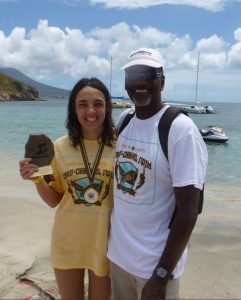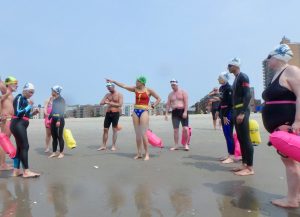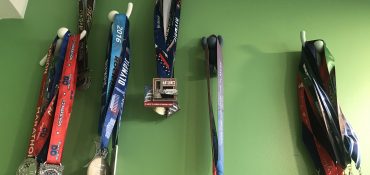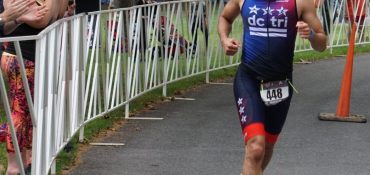
2020 Member Spotlight – Louise Twining-Ward
August, 2020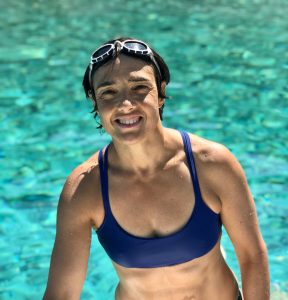 How did you get into open water swimming?
How did you get into open water swimming?
I started open water swimming 10 years ago when a friend at my Masters swim club asked me to join them in a 10-mile swim race across Lake Memphremagog from the US to Canada and back – the Kingdom Swim. Before that summer, swimming more than 500 yards without stopping seemed almost impossible and I was scared of deep water. Somehow when it’s a group endeavor the fear disappears, and with practice you can find your forever pace. With the help from people who have become my best friends, I overcame my fear of swimming in open water, and now, ten years on, I coach others to overcome their fears.
What are some of your favorite swims or spots to swim?
For me it is not so much about location but the water color, the temperature, the feel, and the view. I will swim virtually anywhere it is above 50F, I can see my fingertips when my arms are outstretched under water, and the water does not smell of dead fish! These days I can’t pass a body of water without thinking about how it would be to swim it. I spend most of my bus rides to DC day dreaming about swimming the rivers we are crossing. My favorite spot in New York is Lake Minnewaska. Lake George and Lake Willoughby come in second and third places.
You’ve done some long swims including 19 miles in the Hudson! How was it and how do you prepare for something like that?
That was Stage Five of the Eight Bridges race, from Bear Mountain Bridge to the New Tappan Zee Bridge – also know as “the beast”. It is so named because it’s really a beast. You have a window of about eight hours to make it 19.8 miles before the tide turns. To do that you have to keep up about a punishing 25-minute mile pace all day. Let’s just say the beast is unfinished business.
To train for this kind of a swim you need to slowly increase your weekly yardage from say 6,000 yards to 10,000 and then 15,000 yards. But more than yardage, you have to find your “forever pace” and then make it effortless – reduce your drag, increase your flow, and learn to work with the water flow to propel yourself forward (see Terry Laughlin’s Total Immersion technique).
What nutrition do you use for these long swims?
When I first started marathon swimming I tried everything from mazipan to mars bars for food and coconut water to gatorade on the fluids. Bottom line is you need at least 100 calories every 30 mins and it needs to taste good, be fast to swallow, be easy to throw to you, and not stick in your teeth for the next 30 mins. After a lot of trial and error I have settled on Vanilla bean gu, coconut water and Carbo-pro with touch of cranberry juice! I have friends who somehow swallow mashed potato or egg salad in a tube while swimming. I also crossed Lake Atitlan in Guatemala on peanut butter and jelly. Also keep in mind that in very salty water you need something to ease the pain on your tongue – coconut does it for me.
Most swimmers pause every 30-45 mins to fuel up. I do 30 mins and alternate one time its carbo – pro, the other its gu + coconut water (or just water if I am in fresh water). Here is a link to my recent adventure swim in Sierra Leone – which is pending ratification as the first crossing between Kent and Ricketts (banana island).
https://marathonswimmers.org/swims/2020/twining-ward-li-banana-islands/
What do you enjoy outside of swimming?
Due in part to my wonderful DC Tri club friends I have become a COVID-biker. I am preparing to buy my first road bike so anyone with some good tips to share (or a gorgeous Roubaix to pass on) let me know!
Any fun facts about yourself that you’d like to share?
I coach open water swimming on Brighton Beach in Brooklyn for the club CIBBOWS. I love sharing the joy of open water with others. All DC Tri club members are welcome to join us every Saturday and Sunday at 10am on Brighton Beach Brooklyn (cibbows.org).
